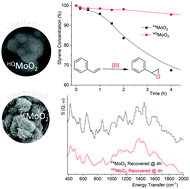Probing the relevance of MoO2 nanoparticles’ synthesis on their catalytic activity by inelastic neutron scattering†
Abstract
Nanosized MoO2 can be prepared by different protocols, which yield different morphologies of the nanoparticles. Among their many properties, they can serve as catalysts for styrene oxidation (among other olefins), which is an industrially relevant transformation. In this work, we prepared MoO2 nanosized catalysts by two slightly different hydrothermal protocols using ethylenediamine and either Fe2O3 or hydroquinone. When used in catalysis, kinetic data evidenced that depending on the synthesis protocol of MoO2, induction periods occur (for the catalyst prepared with hydroquinone) with obvious different kinetic profiles and, in addition, product selectivity was also affected. To gain some insight on what is behind these results of the catalytic activity, a combined approach of studies has been conducted. DRIFT and inelastic neutron scattering (INS) techniques were used to assess the adsorbed species at the surface of both the fresh (DRIFT and INS) and recovered (INS) catalysts. Results from this study showed that when hydroquinone was used, an organic shell coated the MoO2 nanoparticles, which negatively influenced the catalytic performance.



 Please wait while we load your content...
Please wait while we load your content...